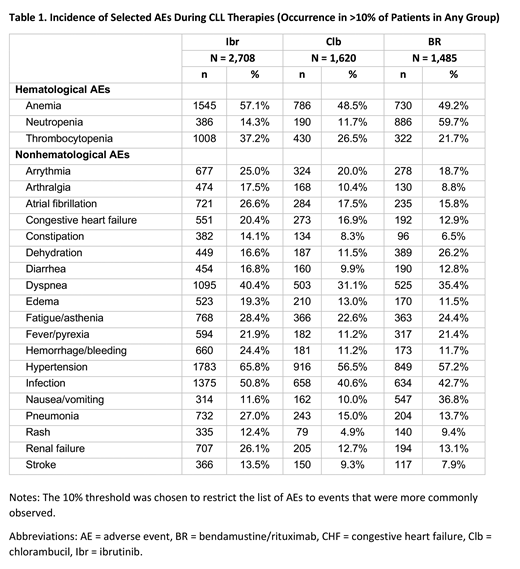Background:
Data on overall survival (OS) and adverse events (AEs) in patients with chronic lymphocytic leukemia (CLL) are mostly available from controlled trials, with limited data from routine clinical practice. We therefore conducted a population-based retrospective cohort study to assess OS, incidence of AEs, and economic burden in patients treated for CLL.
Methods:
Patients with CLL receiving ≥ 1 systemic therapy from 2013-2015 were selected from the Medicare claims database and followed through 2016. The date of the start of first observed therapy served as the index date. Patients were required to have at least 12 months of continuous Medicare enrollment with no evidence of systemic therapy for CLL and/or SCT before the index date. An observed therapy regimen was defined as the combination of all agents received within 35 days after (and including) the first claim for a systemic therapy drug. Therapy was considered ended upon switch to a different regimen or a gap ≥ 90 days after the last treatment. OS was assessed from the index date until the last follow-up or death using the Kaplan-Meier method. Incidence of hematologic and nonhematologic AEs during treatments were assessed for the most commonly observed regimens. The incidence of AEs was based on the presence of at least one claim containing an AE-specific diagnosis code during the treatment, regardless of any history of the AE before treatment initiation. All-cause direct medical costs were assessed from the Medicare's perspective.
Results:
We analyzed 7965 patients (median age=76 years) who met the inclusion criteria. In the overall study follow-up (across all observed therapy lines), ibrutinib monotherapy (Ibr; n=2708) was the most frequent regimen, followed by chlorambucil monotherapy (Clb; n=1620) and bendamustine/rituximab (BR; n=1485). Median length of follow-up from the index date was 19 months for Ibr, 21 months for Clb, and 24 months for BR. Median OS was reached only for Clb (40.8 months [95% CI = 38.6-not reached]). 24-month OS rates for Ibr, Clb, and BR recipients were 69% (95% CI = 68%-71%), 68% (95% CI = 65%-71%), and 79% (95% CI = 77%-81%), respectively. The incidence of the most frequent AEs (occurrence in >10% of patients) are presented in Table1 1; estimates in bold indicate that the incidence of the AE was higher by ≥ 5 percentage points than in the noted trials (Woyach, 2018, N Engl J Med; Burger, 2015, N Engl J Med). The mean per patient per month costs, among all patients, were $1,915 (SD = $2,453) during the baseline period and $8,974 (SD = $11,562) during the period after initiation of the first observed CLL-directed systemic therapy. Mean monthly all‐cause costs increased by the number of AEs (from $5,144 [SD = $5,409] among those with 1-2 AEs to $10,077 [SD = $12,542] among those with ≥6 AEs).
Conclusion:
To our knowledge, this is the largest contemporary observational study reporting outcomes among CLL patients initiating treatments in a real-world setting. Over two-thirds of patients survived ≥2 years after start of the first observed therapy during the study period. Incidence for several hematologic and nonhematologic AEs during the common CLL therapies observed in this study appear to be higher than those reported in the noted clinical trials, highlighting potentially greater susceptibility to these AEs and an unmet medical need in Medicare patients with CLL treated in routine practice. This study also highlights a substantial economic burden that exists in the period after initiation of treatment for CLL.
Goyal:RTI Health Solutions: Employment. Nagar:RTI Health Solutions: Employment. Kabadi:AstraZeneca: Employment, Equity Ownership. Davis:RTI Health Solutions: Employment. Le:AstraZeneca: Employment, Other: Stocks. Kaye:RTI Health Solutions: Employment.
Author notes
Asterisk with author names denotes non-ASH members.


This feature is available to Subscribers Only
Sign In or Create an Account Close Modal